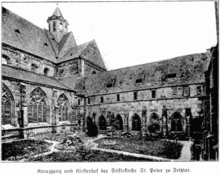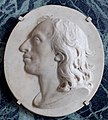Pierre-Etienne Monnot
Pierre-Etienne Monnot (also Pietro Stefano * 9. August 1657 in Orchamps-Vennes , † 24. August 1733 in Rome ) was a French sculptor of the Baroque .
Life
Pierre-Étienne Monnot was the son of the French wood sculptor François-Alexandre Monnot , who introduced him to sculpture. In 1676 he was trained in Dijon by Jean Dubois and then in 1678 in the studio of Pierre Le Gros .
In 1678 he returned to Franche-Comté and created his first independent sculptural work. The first works were initially made of wood . With his father he created the reliefs with passion scenes for the Chapamps de l'Oratoire (town hall) in Poligny . He executed painterly models by Charles Le Brun in Paris and created powerful light and shadow plays by combining low and high relief based on the sculptural work of his teacher Dubois. Monnot toured Paris between 1679 and 1681 and between 1684 and 1686, where he worked for Louis XIV . In 1687 Monnot settled in Rome, where he joined the Burgundian community of the Confrérie St-Claude and was appointed its annually elected rector several times . In 1695 the sculptor was accepted into the artists' association Congregazione dei Virtuosi al Pantheon , which dealt artistically with religious and philanthropic tasks. In the same year he works on the construction of the chapel of San Ignazio in the church of Il Gesù . For this chapel the bronze relief St. Ignatius frees prisoners and the marble statues holding two angels and Christ were created . The Cappella Capocaccia of the Church of Santa Maria della Vittoria was decorated by the sculptor with the reliefs Adoration of the Shepherds and Rest on the Flight . He implemented a style of representation in the footsteps of Domenico Guidi . With the protection of Livio Odescalchi , of whom Monnot made a marble portrait medallion in 1695 ( Louvre ), in 1697 he was commissioned to create the tomb for Pope Innocent XI. in the Peterskirche . In 1708 the same client commissioned him to build a marble statue of Saint Paul for the Basilica of San Giovanni in Laterano . He then completed a statue of Saint Peter begun by the sculptor Jean-Baptiste Théodon . In Rome, Monnot accepted orders for European princes. For John Cecil , 5th Earl of Exeter , he created John Cecil's tomb from 1700 to 1704 and for his wife Anne Cavendish in Stamford - Lincs . In 1701 he designed the marble donor busts of John Cecil and his wife for Saint Martin's Church in Stamford, and for Burghley House he created marble statues. For the Hessian Landgrave Karl , he decorated the marble bathroom in Kassel with twelve groups and statues of gods and goddesses as well as eight mythological reliefs on the Metamorphoses of Ovid from 1712 to 1728. An ensemble was created that is characterized by powerful and voluminous, stocky, massive body shapes .
plant
The art spread through Monnot's sculptural work in England and Germany now assumed an international dimension. In his balanced style of representation, Monnot attached particular importance to gentle facial features and measured gestures, which heralded the French style of the 18th century.
Museum reception
- Head of Christ , terracotta, Besançon .
- Monument to François-Alexandre Monnot, marble, 1728 cloister , Fritzlar Cathedral , Fritzlar ,
- Karlsaue State Park , orangery , marble bath: Landgrave Karl von Hessen-Kassel ; Maria Amalie von Courland , medallions; The four elements ; The four seasons , reliefs, all marble, first quarter 18th century
- Lorraine Museum: Christ. Madonna (attributed to), busts, terracotta, both painted in terracotta, Nancy .
- The Four Elements , 1693; Reception of the Queen of Poland by Prince Odescalchi , 1699 to 1700; Diana on the hunt ; The forge of the Vulkan , both before 1713, all reliefs, terracotta, Paris , Louvre
- Church of San Maria del Popolo: Cardinal Savo Millini, bust, marble, 1699; St. Peter's Square , Piazza Retta, Colonnade; Saints. Pelagia, 1703
- Church of San Ignazio: double grave for Pope Gregory XV. and Cardinal Ludovico Ludovisi, marble, 1709 to 1713 (together with Pierre Le Gros 1666), Rome
Exhibitions
- 2001: Lons-le-Saunier, MBA (K).
Picture gallery
literature
- Monnot, Pierre-Etienne . In: Hans Vollmer (Hrsg.): General lexicon of fine artists from antiquity to the present . Founded by Ulrich Thieme and Felix Becker . tape 25 : Moehring – Olivié . EA Seemann, Leipzig 1931.
- Literature by and about Pierre-Étienne Monnot in the catalog of the German National Library
- Karlheinz W. Kopanski, Karl Weber (ed.): The marble bath in the Kassel Karlsaue. Schnell and Steiner, Regensburg 2003.
- Thomas Ludwig: Ovid Metamorphoses. Schnell and Steiner, Regensburg 2002.
- Kai R. Mathieu (Ed.): Marmorbad Kassel. Schnell and Steiner, Regensburg 2001.
- Thomas Fuchs: Tradition and innovation in the work of Pierre-Etienne Monnot. Publishing house and database for the humanities, Weimar 1997.
Web links
Individual evidence
- ↑ Pierre-Étienne Monnot. at artnet.de, accessed on March 23, 2018.
- ^ Stefanie Walker: The Sculptor Pietro Stefano Monnot in Rome, 1687–1713. Ann Arbor, 1994, p. 29.
- ↑ Ludwig Burk: Pierre-Étienne Monnot and the emergence of the Kassel marble bath - new archive finds. at jstor.org , accessed March 23, 2018.
| personal data | |
|---|---|
| SURNAME | Monnot, Pierre-Etienne |
| ALTERNATIVE NAMES | Monnot, Pietro Stefano |
| BRIEF DESCRIPTION | French baroque sculptor |
| DATE OF BIRTH | August 9, 1657 |
| PLACE OF BIRTH | Orchamps-Vennes |
| DATE OF DEATH | August 24, 1733 |
| Place of death | Rome |









